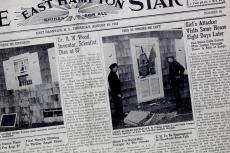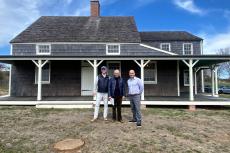This photograph is indicative of the damage brought on by the infamous Hurricane of 1938. The building shown with its side destroyed is White’s Drugstore in Montauk. The September storm wreaked havoc on Long Island, ripping up trees, destroying houses, and flooding the shoreline. It started in the Cape Verde Islands, headed to Florida, and then up the East Coast, making landfall in Bellport on Long Island.
What is particularly interesting about this storm is that there was little to no warning for those in its path. Sept. 21, 1938, offered no signs of a coming storm, and people went about the day as normal. Later in the day, however, things started to get worse as a Category 3 hurricane approached. Unfortunately at the time, word of mouth was often the most reliable and accessible way to get news about the weather.
Along the shore, the storm surges reached over 12 to 25 feet high, with wind speeds of 180 miles an hour. It was the strongest and deadliest hurricane to hit the Island, killing more than 600 people as it traveled north toward New England. The whole Island struggled with power outages and flooding, and many boats and structures were lost along the beaches. On the South Fork, the storm surge created the Shinnecock Inlet and flooded the Napeague stretch, turning Montauk into an island. When it comes to wind speed and destruction, this giant storm ranks with those that came ashore here in 1811 and 1815.
In total, the damage reached upward of $300 million, equivalent to $18 billion today. Although we rebuilt, the storm changed Long Island forever. It is one example of how the Long Island Collection has successfully documented memories, records, and photographs of storms and their aftermath.
Mayra Scanlon is a librarian and archivist in the East Hampton Library’s Long Island Collection. Questions and suggestions can be emailed to Andrea Meyer, the head of the collection, at [email protected].



